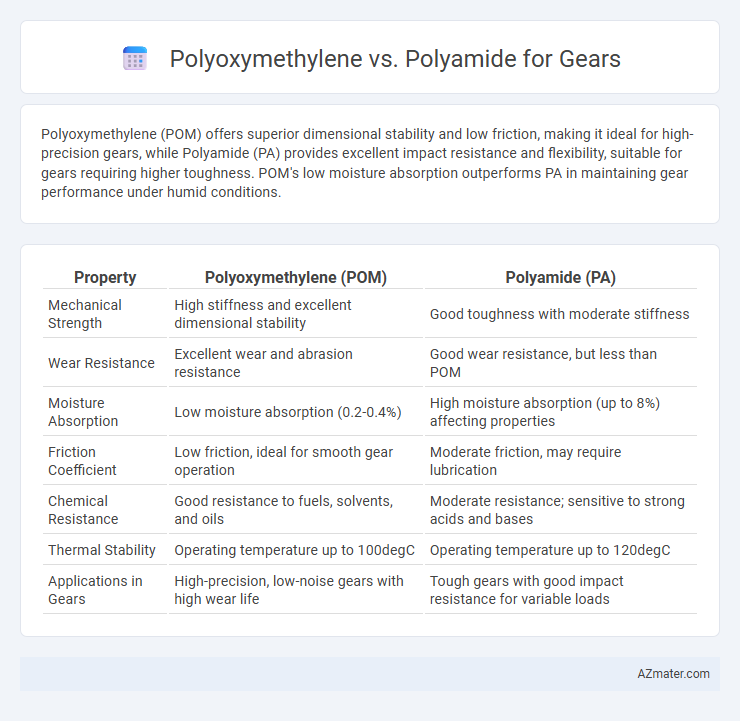Polyoxymethylene (POM) offers superior dimensional stability and low friction, making it ideal for high-precision gears, while Polyamide (PA) provides excellent impact resistance and flexibility, suitable for gears requiring higher toughness. POM's low moisture absorption outperforms PA in maintaining gear performance under humid conditions.
Table of Comparison
| Property | Polyoxymethylene (POM) | Polyamide (PA) |
|---|---|---|
| Mechanical Strength | High stiffness and excellent dimensional stability | Good toughness with moderate stiffness |
| Wear Resistance | Excellent wear and abrasion resistance | Good wear resistance, but less than POM |
| Moisture Absorption | Low moisture absorption (0.2-0.4%) | High moisture absorption (up to 8%) affecting properties |
| Friction Coefficient | Low friction, ideal for smooth gear operation | Moderate friction, may require lubrication |
| Chemical Resistance | Good resistance to fuels, solvents, and oils | Moderate resistance; sensitive to strong acids and bases |
| Thermal Stability | Operating temperature up to 100degC | Operating temperature up to 120degC |
| Applications in Gears | High-precision, low-noise gears with high wear life | Tough gears with good impact resistance for variable loads |
Introduction to Polyoxymethylene and Polyamide
Polyoxymethylene (POM), also known as acetal, is a high-performance engineering thermoplastic characterized by its excellent dimensional stability, low friction, and high wear resistance, making it ideal for precision gears. Polyamide (PA), commonly referred to as nylon, offers strong mechanical properties, good impact resistance, and high fatigue strength, suitable for gears exposed to dynamic loads and varying environmental conditions. Both materials provide distinct advantages: POM excels in smooth operation and low moisture absorption, while PA benefits from better toughness and chemical resistance.
Material Overview: Polyoxymethylene (POM)
Polyoxymethylene (POM) is a high-performance engineering thermoplastic known for its exceptional stiffness, low friction, and excellent dimensional stability, making it ideal for precision gears. Its superior wear resistance and low moisture absorption provide enhanced durability and consistent mechanical properties compared to polyamide (PA), which tends to absorb more water and swell. POM's strong chemical resistance and excellent fatigue endurance contribute to smoother operation and longer lifespan in gear applications.
Material Overview: Polyamide (PA)
Polyamide (PA), commonly known as nylon, exhibits excellent wear resistance, high tensile strength, and superior fatigue endurance, making it a preferred material for gear manufacturing. Its inherent self-lubricating properties reduce friction and noise during operation, enhancing gear performance in dynamic applications. When compared to polyoxymethylene (POM), polyamide offers better impact resistance and moisture absorption, influencing dimensional stability in humid environments.
Mechanical Properties Comparison
Polyoxymethylene (POM) offers superior stiffness and wear resistance compared to polyamide (PA), making it ideal for high-precision gear applications requiring low friction and dimensional stability. Polyamide exhibits greater impact resistance and higher flexibility but tends to absorb moisture, which can affect its mechanical performance and dimensional accuracy in gears. The choice between POM and PA gears depends on specific requirements for load capacity, environmental exposure, and operational durability.
Wear and Friction Performance
Polyoxymethylene (POM) offers superior wear resistance and low friction coefficients, making it ideal for high-precision gears requiring smooth operation and prolonged service life. Polyamide (PA), while providing good toughness and flexibility, tends to exhibit higher friction and faster wear under heavy load and high-speed conditions. Optimizing gear performance in demanding applications favors POM due to its excellent dimensional stability and minimal lubricant dependency compared to polyamide.
Thermal Stability and Operating Temperatures
Polyoxymethylene (POM) exhibits superior thermal stability with continuous use temperatures up to 100degC and short-term exposure up to 120degC, making it suitable for gears in moderate thermal environments. Polyamide (PA), particularly Nylon 6 and Nylon 6/6, offers a wider operating temperature range from -40degC to 150degC but can absorb moisture, which affects its dimensional stability and thermal resistance in gear applications. For high-precision gears requiring consistent performance under thermal stress, POM is preferred due to its low moisture absorption and stable mechanical properties at elevated temperatures.
Chemical Resistance and Durability
Polyoxymethylene (POM) offers superior chemical resistance against solvents, fuels, and alkalis, making it highly durable for gears exposed to harsh industrial environments. Polyamide (PA), while robust and flexible, tends to absorb moisture, which can reduce its long-term durability and chemical resistance in acidic or humid conditions. For applications demanding high durability and resistance to aggressive chemicals, POM gears outperform polyamide counterparts due to their lower water absorption and stable mechanical properties.
Cost Analysis and Availability
Polyoxymethylene (POM) gears typically offer a lower cost per unit compared to polyamide (PA) gears due to more efficient manufacturing processes and higher material availability. POM's widespread production ensures consistent supply and reduces lead times, making it a cost-effective choice for high-volume applications. In contrast, polyamide gears, while versatile, often incur higher costs and variable availability influenced by fluctuations in raw material supply and demand.
Typical Applications in Gear Manufacturing
Polyoxymethylene (POM) is widely used in precision gear manufacturing due to its high stiffness, low friction, and excellent dimensional stability, making it ideal for automotive transmission systems, office equipment, and consumer electronics. Polyamide (PA), commonly known as nylon, offers superior impact resistance and wear properties, suitable for heavy-duty gears in industrial machinery, conveyor systems, and agricultural equipment. Both materials support gear applications where durability and performance are critical, but POM is preferred for low-noise, high-precision gears, while PA excels in applications requiring toughness and chemical resistance.
Choosing the Right Material for Gears
Polyoxymethylene (POM) offers excellent dimensional stability, low friction, and high wear resistance, making it ideal for precision gears requiring smooth operation and long service life. Polyamide (PA), known for its toughness and flexibility, performs well in applications subject to impact and varying loads but may absorb moisture, affecting its mechanical properties. Selecting the right material depends on gear requirements such as load capacity, environmental exposure, and desired durability, with POM preferred for high-precision, low-friction gears and PA favored for shock-absorbing and cost-effective solutions.

Infographic: Polyoxymethylene vs Polyamide for Gear
 azmater.com
azmater.com